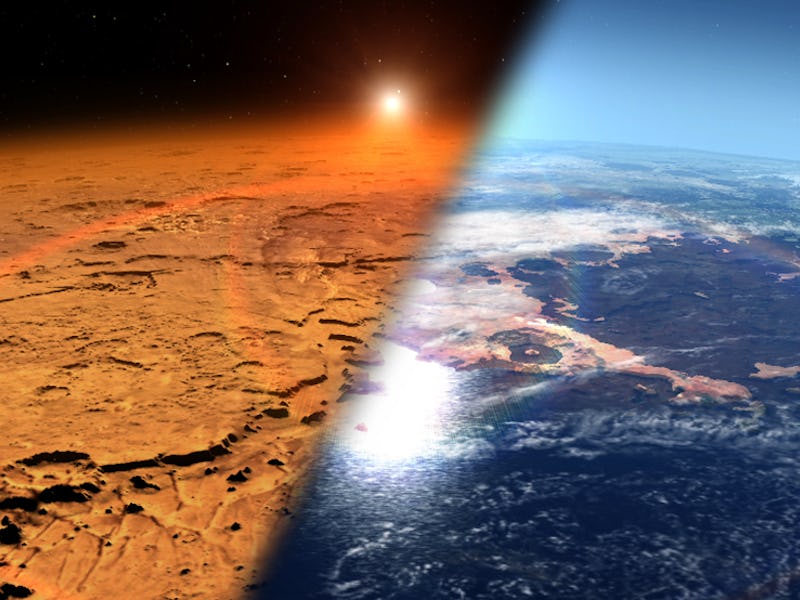NASA funds a key piece of technology to confirm life on Mars
MAPS will fire precious samples of dust and rock off the Red Planet for return back to Earth.

In an effort to find out whether our neighboring planet Mars ever housed life, NASA is one step closer to retrieving precious samples from the Red Planet that could potentially hold clues to ancient aliens.
On March 4, NASA awarded the contract for the Mars Ascent Propulsion System (MAPS) to Northrop Grumman Systems Corporation, a private aerospace company. The contract tasks Northrop Grumman with building components of a vehicle that will travel to Mars as part of the plan to bring back samples from the Red Planet to analyze on Earth.
READ MORE PERSEVERANCE ROVER NEWS FROM INVERSE
Northrop Grumman will design and develop the propulsion system for the Mars Ascent Vehicle (MAV), as well as other supporting equipment, over a 14-month period. The contract is expected to cost around $60 million. The mission has a potential launch date slated for 2026.
“We are committed to help build the rockets that will orbit the samples Perseverance collects so they can be returned to Earth,” Rebecca Torzone, vice president of missile products at Northrop Grumman, said in a press release.
An illustration of the NASA Mars Ascent Vehicle that would be launched from the Martian surface, carrying precious samples from the red planet.
WHAT'S NEW — The Mars Sample Return program is still in the works. So far, we know it involves sending a Sample Fetch Rover and Mars Ascent Vehicle to the Martian surface to collect and return the samples Perseverance has (hopefully) collected back to Earth.
NASA’s Perseverance rover landed on the surface of Mars on February 18, and a crucial part of its mission is to collect rock and dust samples from the surface of Mars and stow them away for a future mission to scoop them up.
Grumman will provide the propulsion system that will make up a part of a two-stage vehicle sent to collect the samples, stow them onboard, and then launch them back into Martian orbit.
As part of the mission, a Mars lander will first arrive near Jezero Crater, Perseverance’s landing site. The 28-mile wide, 1,600-foot deep crater is located in a basin slightly north of the Martian equator. Jezero Crater is believed to have once housed a lake, which is estimated to have dried out some time between 3.5 and 3.8 billion years ago.
The lander will carry the ascent vehicle along with a Sample Fetch Rover (SFR), which is being designed by the European Space Agency. This new rover is roughly the same size as NASA's Opportunity rover — about the size of a sedan.
The SFR will gather the cached samples and carry them back to the lander to transfer them back to the ascent vehicle. From there, the ascent vehicle will launch from the surface and deploy a special container carrying the samples into the Martian orbit to be later picked up by an orbiting spacecraft. If all that goes to plan, then the orbiting spacecraft will bring the sample back to Earth.
The tire tracks of Perseverance’s first drive on Mars. The rover will soon begin collecting samples to be returned at a later date.
HERE'S THE BACKGROUND — Mars is a desolate world today, but evidence suggests that the Red Planet may have once been a habitable environment replete with lakes, streams, and even oceans.
NASA’s Perseverance rover touched down earlier this year armed with tools to help it dig for clues of ancient life that may have once existed on Mars.
Perseverance carries nine drill bits which the rover will use to collect samples of Martian rock and dust. The samples will move through the belly of the robot into the Adaptive Caching Assembly System, where they are assessed and processed.
Samples which the rover deems intriguing will be stowed away in special tubes and left in a marked area on Mars for future sample return missions.
WHY IT MATTERS — This intricate process will allow scientists to probe at Martian rock in a lab for the first time.
Meteorites from Mars have landed on Earth and been analyzed before, but these space rocks are altered by Earth’s atmosphere as they journey their way from the Red Planet.
However, being able to analyze pure Martian samples for the first time will help scientists determine whether or not the Red Planet contained signs of ancient microbial life. In turn, this will answer whether life exists beyond Earth — and may even tell us whether that life is similar or entirely different to life forms on our home planet.